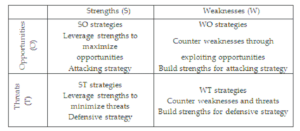Webinar recap: the roadmap for every business to develop a successful business strategy
Last month I had the pleasure to attend a very interesting webinar from Johan Van Haverbeke about the roadmap to an successful business strategy. To give you a glimpse, here are some key takeaways from the webinar!
1. Take a step back
Many businesses are facing the challenge to adapt their strategy into this quickly evolving world that is becoming more and more digital. The pandemic has given many of us the chance to rethink about their business strategy. That’s why it’s important to take a step back and take time to understand the pain points of your strategy and rethink the strategy in order to discover the new and unmet needs of your customer.
Two tools that will help you:
- Internal analysis: define your short to long-term goals and identify the current competition advantage
- External analysis: make an clear overview of the macro-environmental factors that has an impact on your business
Remember this step should be an ongoing process and not only when situations will force you to rethink about the strategy. By recognising and overcoming the common pitfalls will let your business continue to grow and thrive. So evaluate the steps that you’re taking today and make sure they don’t create additional problems for the future.
2. Strategy is choosing about what not to do and not what to do
The essence of an good strategy is choosing what not to do. In this crucial step you will have to make choices by weigh one option against the other. In the end you want to stand out and choose strategic options that are hard to copy. A SWOT-analysis is a common tool that you’ve probably heard of. However, the value of a swot analysis is often underestimated despite the simplicity in its creation. So do not only list all the key elements of your SWOT-analysis but use this to consider how elements are overlapping with each other in your business. This is also called the TOWS matrix. For example, you can develop strength-opportunity strategies by using the identified strengths to maximize the opportunities.
The following model can help you to define the strategy in each area:

Source: Researchgate
3. Communication is key
The main reason why the strategy doesn’t succeed is the lack of communication throughout the whole company. Effective communication should be two-sided and it can help to build trust towards the employees which will enhance the authenticity and credibility of the strategy. Your employees should have a clear vision about the strategy by receiving the right information in order to minimizes the failures. The more trust and credibility you obtain, the more your employees believe in your strategy and will contribute to it. In addition, effective communication saves time and energy that can be spent on the execution.
3 things will help you to communicate more effectively:
- By listening to your employees you will figure out if they understand the value and vision of the strategy.
- Open communication and transparency creates trust. The more your employees feel engaged the more they are willing to commit to the achieving the goal and understanding the strategy.
- Simplify the strategy in order to make it understandable for your employees. The strategy should be explained in a short and simple way.
Want to learn more?
Subscribe to our marketing newsletter and receive the latest tips and tricks to take your strategy to the next level!
Subscribe now

